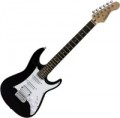Material
The material from which the body of an electric guitar is made. For models with cutouts (semi-acoustic, see "Type"), in this case, only the material of the back deck and sides can be taken into account, and data on the top deck is given separately (for more details, see "Deck Cover Material").
Now on the market there are cases of such trees:
red,
maple,
agatis,
ash,
alder.
It makes no sense to dwell on each of the materials found in modern electric guitars. Their variety is very large, however, unlike acoustic guitars, the body in this case does not play such a significant role in shaping the sound, and its material has a relatively small effect on the acoustic properties of the instrument (although the exact degree of such influence is a moot point). If you wish, you can find detailed data on a particular material in special sources, but in fact it makes sense to look primarily at the appearance of the instrument and its price category.
Number of frets
The fret is the gap between the nut on the fretboard; each such interval is responsible for its own note (the interval between the frets is half a tone). Accordingly, the more frets, the more notes you can play on one string. However, keep in mind that the width of the gaps between the nut decreases as you get closer to the bridge, and if there are a lot of frets, playing at high frets can be difficult, requiring very high accuracy.
The most popular options today are
22 or
24 frets, they are found in most electric guitars of all types. In basses, there are also a smaller number (
20 frets and
21 frets), because. the distance between the nut on such instruments is greater, and the necks, respectively, with the same number of frets, are longer than those of guitars.
In general, paying attention to this parameter makes sense, first of all, for professional musicians, for whom a vast “space for manoeuvre” is fundamentally important.
A separate category is
fretless instruments, completely devoid of nut. Almost all of them relate to bass guitars; there are also electric guitars without frets, but very rarely. In such instruments, the role of the nut is played by the musician's finger, which presses the string to the fretboard. The technique of playing fretless guitars is noticeably mor
...e complicated: firstly, to extract clean notes, you need a very precise position of the finger; secondly, this design reduces the volume of the sound and the duration of the sustain, and special playing techniques may be required to obtain the sound of the desired volume (and heavier strings for basses). On the other hand, the lack of frets gives the professional musician a number of additional options. For example, on a fretless neck, you can make very smooth slides, without stepping between notes, and the instrument itself is not tied to a standard 12-step scale, which can be very useful in some areas of music (experimental, oriental, etc.). Also note that the fretless bass guitar, both in sound and playing technique, is very close to the classical double bass, which is especially appreciated by lovers of jazz and other similar styles.Strap
Shoulder strap included with electric guitar.
The strap not only allows the musician to play while standing, but can also come in handy in a sitting position. This is due to the fact that electric guitars (unlike acoustic ones) have a relatively small body thickness, and often also a specific shape; as a result, it can be difficult, if not impossible, to keep such an instrument on your knee without additional support. And even for semi-acoustic instruments (see "Type"), where this moment is not so pronounced, an additional "suspension" on the shoulder may be useful. Thus, an electric guitar strap is highly desirable anyway, and its presence in the kit can be very convenient — you don’t have to look for this accessory separately. On the other hand, almost all tools use the standard strap attachment, and the included strap may not be the correct length or design. Therefore, this configuration option is extremely rare, mainly among low-cost models — it is assumed that sophisticated guitarists prefer to choose a strap on their own, according to their own preferences.
Picks
A set of
picks is included with the guitar.
A pick is a small plate used when picking sound from strings. Using such a plate provides a more pronounced, accented sound than playing with fingertips; in addition, it is easier to use a plectrum to "metre" the effect on the string in terms of strength and sharpness. Thus, this way of playing is used by most guitar players, including world-class stars.
If picks are included in the package, then there are usually several of them — of different rigidity; thus, the guitarist can choose the most suitable option, depending on his own preferences and the characteristics of the technique. However, such equipment is rare and is typical mainly for low-cost instruments designed for beginners (of the “my first electric guitar” format). This is due to the fact that more or less experienced musicians often prefer not to rely on the choice of the manufacturer, but to purchase picks separately, in accordance with their own criteria.

